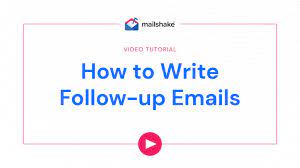Mastering the Art of Email Follow-up: Understanding the Importance and Strategies for Effective Communication
Email communication is an essential part of our daily lives and has become a standard mode of communication for both personal and professional purposes. Despite the convenience email provides, the lack of immediate response can lead to misunderstandings, forgotten obligations, and loss of opportunities. Therefore, mastering the art of email follow-up is crucial for effective communication.
The Importance of Email Follow-up
Follow-up emails are essential, primarily for business correspondence. It serves as a reminder of previous communication or to ensure that your message was received and understood. It also provides an opportunity to reiterate your message, highlight important details, or request any necessary action. Many different situations warrant follow-up emails, such as job applications, proposals, or sales pitches.
Email follow-up helps you maintain communication and build relationships with your contacts. A well-drafted follow-up email demonstrates professionalism, enthusiasm, and dedication, which can help establish trust and credibility with a potential employer, client, or business partner. Consistent communication also helps you stay top of mind with your contacts, increasing the likelihood of future business opportunities.
Strategies for Effective Email Follow-up
1. Define your objectives: Before drafting your follow-up email, clarify your objectives by considering the recipient and the context of the previous communication. Define your goal, intentions, and expectations for the follow-up email.
2. Timing: Timing is key while drafting a follow-up. Ensure you give the recipient enough time to respond to your initial message before following up but do not wait too long to send your follow-up email, as it may lead to losing the opportunity or creating inconvenience for the recipient.
3. Personalize: Always personalize your follow-up email. Use the recipient’s name, mention the previous conversation, and keep the tone friendly yet professional.
4. Keep it concise: The email must be clear, concise, and to the point. Avoid lengthy paragraphs and stick to the necessary information. Highlight the critical details, and ensure all questions get answered.
5. Be polite and positive: Maintain a respectful tone throughout the email, even if the recipient does not respond as expected. Use phrases like “thank you” and “looking forward to hearing from you.” Avoid any negative-sounding words and keep it positive.
6. Use an appropriate closing: The closing section is equally as important as the opening. Use a suitable closing line that reflects your tone and intentions. Common choices include “Sincerely,” “Best regards,” or “Thank you.”
Tips for Drafting Effective Follow-up Emails
1. Tone: Use a friendly but professional tone that reflects your personality while maintaining appropriate etiquette.
2. Clarity: Ensure your message is clear and concise so that the recipient understands your intent.
3. Timing: Determine an appropriate following schedule depending on the situation to avoid being too pushy.
4. Personalization: Personalize your email following the recipient’s preferences and the context of the previous communication.
5. Proofreading: Reread and proofread your email to ensure it is free of errors and conveys your message accurately.
Some Email Follow-up Templates
1. Job Application:
Dear [Recipient Name],
I wanted to follow up on the job application I submitted in [Date]. I am eager to learn more about the position and to discuss my qualifications with you. I look forward to hearing from you.
Thank you for your time and consideration.
2. Sales Pitch
Hello [Recipient Name],
I hope this email finds you in good health. I am just checking in to see if you have any questions about the proposal I sent last week. I am excited to work with you on [Product/service], and I believe my [product/service] can be an excellent addition to [company name].
Best regards,
[Your Name]
3. Networking
Dear [Recipient Name],
It was a pleasure meeting you at [event name]. I enjoyed our conversation on [topic] and would love to continue that discussion. Also, I would love to stay in touch with you. Please let me know if you are available to discuss more over a coffee or virtual meeting.
Best regards,
[Your Name]
Conclusion
Email follow-up is a crucial aspect of communication today. It helps build and maintain relationships, demonstrate professionalism, and increase opportunities. However, effective email follow-up requires proper planning, personalization, and an appropriate tone. By incorporating the strategies and tips mentioned in this article, you can master the art of email follow-up and achieve the desired outcome.
FAQs
The wait time depends on the context of the previous communication. Typically, three to five business days is a reasonable period for most situations.
The subject line should be specific to the message and mention the original email to help the recipient recognize the content and intent.
It is best to limit your follow-up to two or three emails. Persisting beyond that may give the impression that you are too persistent or pushy.
Addressing the recipient by their last name is common when you are not familiar with the individual. However, if you’ve already met before or have interacted via email, addressing them by their first name is a friendly approach.
Humor can be effective and establish positive sentiment, but it is best to consider the recipient’s personality before incorporating humor into your message. It should align with your brand and not offend or distract the recipient.


